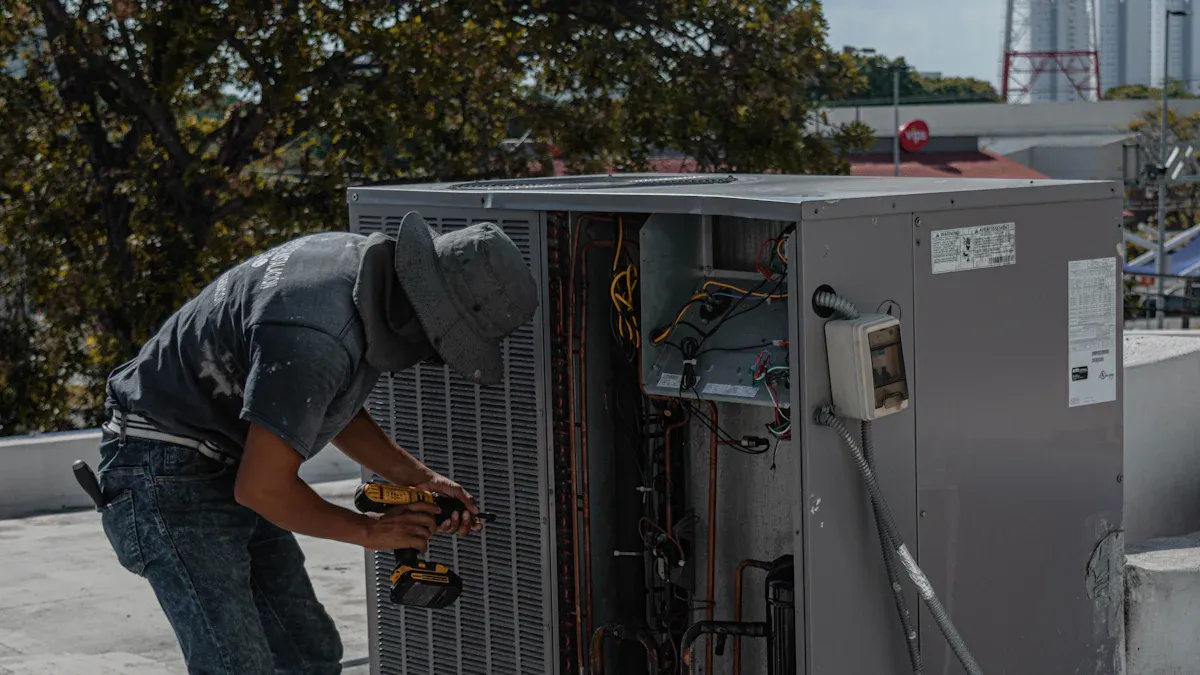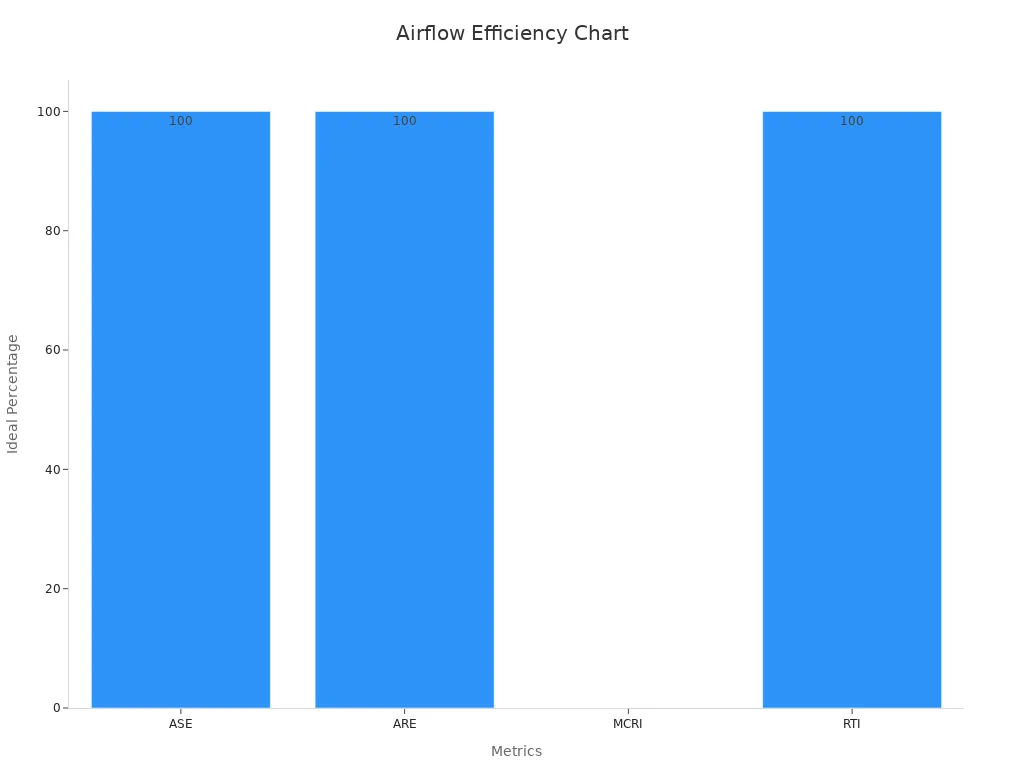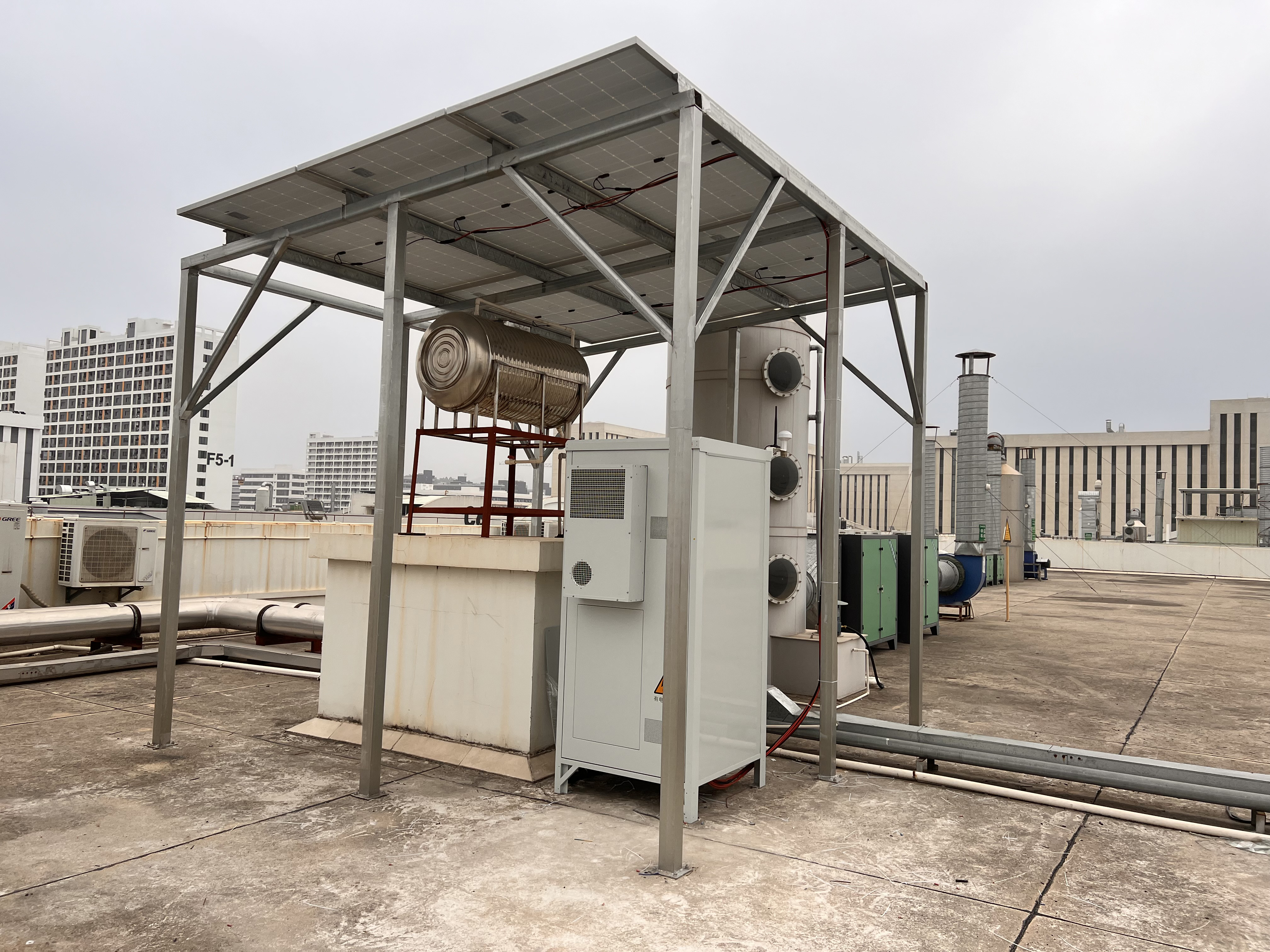How to Save Energy with ESTEL Outdoor Cabinet Air Conditioners

Saving energy with an outdoor cabinet air conditioner isn't just about cutting costs—it's about making smarter choices for the environment. ESTEL's energy-efficient units make this easier. For example, using cooperative mechanisms can slash energy use by up to 61%. Imagine the savings on electricity bills while reducing your carbon footprint. 🌱
Key Takeaways
Pick energy-saving models to cut costs and help the planet. Find ENERGY STAR units for sure efficiency.
Clean filters and coils often to keep it working well. This also helps your air conditioner last longer. Check filters every month for good airflow.
Set your thermostat to 78°F in summer and 68°F in winter. This keeps you comfy and saves energy. A smart thermostat can make it easier to adjust.
Why Energy Efficiency is Crucial for Outdoor Cabinet Air Conditioners
Benefits of Energy Efficiency
Energy efficiency isn't just a buzzword—it's a game-changer for outdoor cabinet air conditioners. When you choose energy-saving models, you're not only cutting down on power consumption but also saving money in the long run. Here's why it matters:
Energy-efficient air conditioners reduce operating costs, giving you more control over your budget.
They align with sustainability goals, helping you contribute to a greener planet. 🌍
These units are designed for optimal energy consumption, which is especially important for remote locations where power resources may be limited.
By investing in higher EER and SEER ratings, you're ensuring your air conditioner works smarter, not harder. This means less strain on the unit and fewer repairs over time.
Tip: Look for ENERGY STAR-certified models to guarantee compliance with high-efficiency standards.
Impact on Performance and Longevity
Energy efficiency doesn't just save money—it boosts performance and extends the lifespan of your outdoor cabinet air conditioner. Here's how:
Units with higher SEER ratings deliver better cooling while slashing energy bills.
Proper installation and home characteristics play a big role in maintaining efficiency.
Regular maintenance, like cleaning filters and tuning up the system, keeps the unit running smoothly.
Metric | Description |
|---|---|
SEER | Measures cooling efficiency over a season, ensuring energy savings. |
EER | Evaluates cooling effectiveness at a set temperature for peak performance. |
ENERGY STAR | Certification for high efficiency, reducing utility costs significantly. |
Energy-efficient models are built to last longer. When you pair them with consistent upkeep, you'll enjoy reliable cooling for years.
Note: Don't underestimate the importance of annual tune-ups—they're key to sustaining performance and avoiding costly breakdowns.
Regular Maintenance for Energy Savings
Keeping your outdoor cabinet air conditioner in top shape doesn't have to be complicated. Regular maintenance not only ensures reliable cooling power but also helps you save energy and extend the life of your unit. Let's dive into the key steps you can take to maximize efficiency.
Clean Filters to Improve Airflow
Dirty filters are one of the biggest culprits behind reduced cooling power and higher energy bills. When filters get clogged, airflow becomes restricted, forcing your air conditioner to work harder. This not only wastes energy but also puts unnecessary strain on the system.
Here's why cleaning or replacing filters regularly is so important:
It keeps airflow steady, ensuring your unit operates at peak efficiency.
It prevents dirt from accumulating on the evaporator coil, which can otherwise reduce its heat-absorbing capacity.
It lowers energy consumption by reducing the workload on the compressor.
Tip: Check your filters every month, especially during peak cooling seasons. If they look dirty, clean or replace them immediately.
Studies back this up. Research by Luorria et al. (1993) found that cleaning ducts and filters improved airflow by 20-30%, significantly boosting energy efficiency. Similarly, Krzyanowskii (1992) highlighted how dust buildup on filters reduces airflow, leading to lower cooling efficiency.
Wash Coils to Maintain Cooling Efficiency
Your air conditioner's coils play a critical role in transferring heat. Over time, dirt and debris can accumulate on the coils, reducing their ability to absorb and release heat effectively. This buildup forces the unit to consume more energy to maintain the desired cooling power.
To keep your coils clean:
Turn off the unit and remove any debris around the coils.
Use a soft brush or a vacuum to gently clean the surface.
For stubborn dirt, use a coil cleaner spray and rinse with water.
Note: Clean the coils at least once a year or more often if your unit is in a dusty environment.
Laatikainen et al. (1991) found that dust accumulation depends on factors like air intake height and filter type. Regular cleaning ensures your system performs efficiently, even in challenging conditions.
Ensure Proper Airflow Around the Unit
Proper airflow is essential for your outdoor cabinet air conditioner to function efficiently. Blocked or restricted airflow can lead to uneven cooling and increased energy consumption.
Here's how you can maintain optimal airflow:
Keep at least two feet of clearance around the unit. Remove any obstructions like plants, furniture, or debris.
Ensure the vents and grilles are clean and free of dust.
Check for any signs of airflow imbalance, such as uneven cooling or hot spots.
To understand the impact of airflow on energy consumption, consider these metrics:
Metric | Description | Ideal Value | Interpretation |
|---|---|---|---|
ASE | Efficiency of cold air utilization | 100% | No loss of cold air, all used for cooling |
ARE | Proportion of hot air returned to AC | 100% | All hot air returned, no internal cycle |
MCRI | Ratio of hot air mixed with intake | 0% | No hot air returned to IT equipment |
RTI | Balance of airflow between AC and cabinet | 100% | Ideal airflow balance |
SHI | Impact of hot air on supplied cold air | 0-1 | Smaller value indicates less loss |

Maintaining proper airflow ensures your unit delivers consistent cooling power without wasting energy.
Pro Tip: Schedule a professional inspection if you notice persistent airflow issues. Technicians can identify and fix problems like duct leaks or fan malfunctions.
Prevent Energy Loss with Proper Sealing

Identify and Seal Air Leaks
Air leaks might seem small, but they can have a big impact on your outdoor cabinet air conditioner's performance. When air escapes through gaps or cracks, your unit has to work harder to maintain the desired temperature. This wastes energy and increases your utility bills.
Start by inspecting the cabinet for any visible gaps around doors, panels, or vents. Use weatherstripping or caulk to seal these areas. Don't forget to check the ductwork too. Leaky ducts can lose up to 30% of the air meant for cooling, which directly affects energy efficiency.
Tip: A simple way to detect leaks is by holding a lit incense stick near potential problem areas. If the smoke wavers, you've found a leak that needs sealing.
Benefits of Preventing Air Leaks
Sealing air leaks offers more than just energy savings. It improves the overall performance of your air conditioner and enhances indoor air quality. Here's a breakdown of the benefits:
Benefit | Description |
|---|---|
Energy Efficiency | Sealing ductwork improves energy efficiency by reducing leaks and unwanted air loss. |
Lower Utility Bills | Effective HVAC operation leads to significantly lower utility bills. |
Improved Indoor Air Quality | Enhanced air quality results from better sealing and reduced air leaks. |
Use of Intelligent Controls | AI and IoT technology optimize temperature management, further reducing energy consumption. |
Economizers for Cooling | Utilizing outdoor air for cooling when conditions are favorable results in substantial energy savings. |
By sealing leaks, you're not just saving money—you're also extending the life of your outdoor cabinet air conditioner. Plus, you'll enjoy consistent cooling without overworking the system.
Pro Tip: Combine proper sealing with regular maintenance to maximize energy efficiency and keep your unit running smoothly for years.
Positioning and Shading for Better Efficiency

Place Units in Shaded Areas
Where you place your outdoor cabinet air conditioner can make a big difference in its efficiency. If you position the unit in a shaded area, it doesn't have to work as hard to maintain cooling power. Direct sunlight heats up the unit, forcing it to consume more energy to cool down. By keeping it out of the sun, you reduce the strain on the system and improve its performance.
Look for natural shade, like trees or shrubs, but make sure they don't block airflow around the unit. If natural shade isn't available, consider installing an awning or a shade structure. These simple adjustments can help your air conditioner run more efficiently and last longer.
Tip: Keep at least two feet of clearance around the unit to ensure proper airflow while benefiting from the shade.
Reduce Solar Heat Gain with Effective Shading
Shading doesn't just help the unit itself—it also reduces the heat entering the space it's cooling. Effective shading can lower the peak heat gain, which means your air conditioner uses less energy to maintain cooling power. During hot seasons, external shading blocks unwanted solar heat, keeping the interior cooler and reducing energy consumption.
Here's how shading makes a difference:
It prevents solar heat from entering conditioned spaces, enhancing energy efficiency.
Well-designed shading devices can cut annual cooling energy use by 5% to 15%.
It reduces the workload on your air conditioner, extending its lifespan.
Consider using window films, overhangs, or reflective materials to block sunlight. These solutions not only save energy but also keep your space more comfortable.
Pro Tip: Combine shading with proper sealing to maximize energy savings and cooling efficiency.
Schedule Professional Maintenance for Long-Term Savings
Importance of Regular Inspections
Scheduling regular inspections for your outdoor cabinet air conditioner is one of the smartest ways to save energy and money. When you stay on top of maintenance, you ensure the system operates at peak efficiency. Neglecting inspections can lead to clogged filters, overheating compressors, and reduced cooling power. These issues not only waste energy but also shorten the lifespan of your unit.
Here's why regular inspections are a game-changer:
They can reduce energy consumption by 15-20%.
Up to 95% of unexpected repairs can be avoided.
The system's lifespan can be extended by 3-5 years.
Inspections also help maintain clean air filters and monitor performance. This prevents failures and ensures your unit delivers consistent cooling power. Some advanced systems even offer remote monitoring, alerting you to potential issues before they escalate. By catching problems early, you avoid costly breakdowns and keep your air conditioner running smoothly.
Tip: Schedule inspections at least once a year, preferably before peak cooling seasons, to maximize efficiency and savings.
How to Choose Reliable Technicians
Finding the right technician is crucial for keeping your air conditioner in top shape. A skilled professional doesn't just fix problems—they optimize your system for better energy efficiency and cooling power. But how do you choose the best one?
Look for technicians who:
Have experience with advanced cooling systems to enhance operational efficiency.
Maintain optimal operating temperatures to prevent overheating of sensitive components.
Use intelligent algorithms for power distribution, reducing energy consumption.
Streamline operations through integrated systems, lowering costs and improving performance.
Criteria | Benefits |
|---|---|
Advanced cooling system expertise | Extends equipment lifespan and saves energy. |
Temperature management skills | Ensures safe operation and reliability. |
Power optimization techniques | Reduces energy use and boosts efficiency. |
Integrated system knowledge | Cuts costs and enhances overall performance. |
Choosing a reliable technician ensures your air conditioner stays efficient, safe, and cost-effective. Don't settle for less—your system deserves the best care.
Pro Tip: Ask for certifications or references to verify a technician's expertise before hiring them.
Saving energy with ESTEL outdoor cabinet air conditioners is easier than you think. Regular maintenance, smart thermostat settings, and proper positioning can make a huge difference. Studies show that air conditioners account for up to 55% of cooling energy use, but strategies like heat exchangers can cut this by 30%.
Study Title | Key Findings | Methodology |
|---|---|---|
Cooling Systems for IT Environment Heat Removal in (Internet) Data Centers | Consistent cooling needs for servers based on heat patterns and energy use. | Reviewed cooling methods and checked environmental conditions. |
Investigation on the energy and air distribution efficiency with improved data centre cooling to support high-density servers | Row-based cooling improves energy and cooling performance. | Measured performance and energy use in real setups. |
Strategies in Energy Conservation and Management of Heating, Ventilating and Air-Conditioning (HVAC) System of a Data Center | Energy-saving strategies and improved cooling methods identified. | Studied energy use and airflow patterns. |
By adopting these practices, you'll save energy, lower costs, and extend your unit's lifespan. Don't forget—regular inspections and sealing air leaks are key to long-term efficiency.
Tip: Start small. Clean filters monthly and check for air leaks to see immediate results.
FAQ
1. How often should you clean the filters on your ESTEL outdoor cabinet air conditioner?
You should clean or replace filters monthly, especially during peak cooling seasons. This keeps airflow steady and improves energy efficiency.
2. Can shading really make a difference in energy savings?
Yes! Placing your unit in shaded areas reduces heat exposure, lowers energy consumption, and extends the lifespan of your air conditioner.
3. Are smart thermostats worth the investment?
Absolutely! Smart thermostats save energy by learning your habits, adjusting temperatures automatically, and offering remote control via apps. They're a game-changer for efficiency.
See Also
Selecting Optimal Cooling Solutions for ESTEL Telecom Cabinets
Enhancing Outdoor Cabinets Through Power, Cooling, And Monitoring
Exploring ESTEL Cooling Solutions for Industrial Cabinet Needs
In-Depth Analysis of Energy-Saving Air Conditioning Units
Efficiently Managed Outdoor Cabinets for Optimal Performance
CALL US DIRECTLY
86-13752765943
3A-8, SHUIWAN 1979 SQUARE (PHASE II), NO.111, TAIZI ROAD,SHUIWAN COMMUNITY, ZHAOSHANG STREET, NANSHAN DISTRICT, SHENZHEN, GUANGDONG, CHINA

